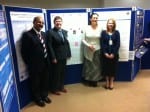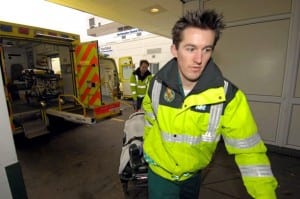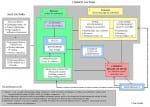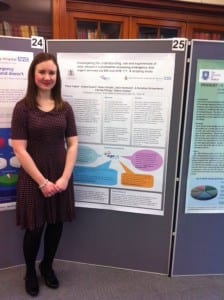 Viet-Hai Phung, Fiona Clapton, Dr Karen Windle, Dr Zahid Asghar, Professor Niro Siriwardena attended the 999 EMS Research Forum in Sheffield on 19 February 2014. Also attending were Nadya Essam, Debbie Shaw, Mohammad Iqbal and Anne Spaight, visiting research fellows at CaHRU based at East Midlands Ambulance Services NHS Trust. This conference was aimed at emergency care practitioners, health service managers, policy makers, as well as academics and researchers like ourselves. Fiona, Zahid and Nadya presented posters and fielded questions on our work on the use of 999 and NHS 111 in Lincolnshire, ethnic differences in cardiac chest pain and the use of Modified Early Warning Scores (MEWS) to inform decision-making among ambulance clinicians respectively.
Viet-Hai Phung, Fiona Clapton, Dr Karen Windle, Dr Zahid Asghar, Professor Niro Siriwardena attended the 999 EMS Research Forum in Sheffield on 19 February 2014. Also attending were Nadya Essam, Debbie Shaw, Mohammad Iqbal and Anne Spaight, visiting research fellows at CaHRU based at East Midlands Ambulance Services NHS Trust. This conference was aimed at emergency care practitioners, health service managers, policy makers, as well as academics and researchers like ourselves. Fiona, Zahid and Nadya presented posters and fielded questions on our work on the use of 999 and NHS 111 in Lincolnshire, ethnic differences in cardiac chest pain and the use of Modified Early Warning Scores (MEWS) to inform decision-making among ambulance clinicians respectively.
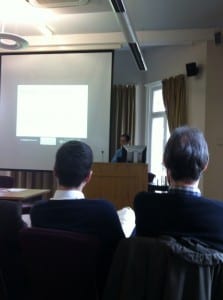 Viet-Hai , whose abstract submission was among the four most highly-rated, gave an oral presentation on the systematic review he has been undertaking with Dr Windle and other members of the team on the barriers and facilitators for minority ethnic groups in accessing prehospital care. The presentation was well-received, with thought-provoking questions both from delegates on the conference floor and outside. The day began with International Exchange Prize Winner, Rachael Wallen, a paramedic from New Zealand, presenting her work on women’s attitudes to 12 lead electrocardiogram acquisition in the ambulance setting. This was followed by Professor Siriwardena and Jo Coster from the University of Sheffield’s School of Health And Related Research (ScHARR) providing an update on the Pre-hospital Outcomes for Evidence-Based Evaluation (PhOEBE) programme.
Viet-Hai , whose abstract submission was among the four most highly-rated, gave an oral presentation on the systematic review he has been undertaking with Dr Windle and other members of the team on the barriers and facilitators for minority ethnic groups in accessing prehospital care. The presentation was well-received, with thought-provoking questions both from delegates on the conference floor and outside. The day began with International Exchange Prize Winner, Rachael Wallen, a paramedic from New Zealand, presenting her work on women’s attitudes to 12 lead electrocardiogram acquisition in the ambulance setting. This was followed by Professor Siriwardena and Jo Coster from the University of Sheffield’s School of Health And Related Research (ScHARR) providing an update on the Pre-hospital Outcomes for Evidence-Based Evaluation (PhOEBE) programme.
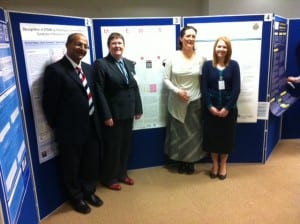 The afternoon session began with representatives from two Patient Public Involvement (PPI) bodies talking about how best to involve patients and the public in pre-hospital emergency care research. This was followed by keynote speaker, Professor Keith Willett from NHS England who presented his organisation’s review of urgent and emergency care and potential future directions. The conference concluded with a panel discussion of the issues raised by Professor Willett’s presentation with Professor Siriwardena and others with particular perspectives on urgent and emergency care.
The afternoon session began with representatives from two Patient Public Involvement (PPI) bodies talking about how best to involve patients and the public in pre-hospital emergency care research. This was followed by keynote speaker, Professor Keith Willett from NHS England who presented his organisation’s review of urgent and emergency care and potential future directions. The conference concluded with a panel discussion of the issues raised by Professor Willett’s presentation with Professor Siriwardena and others with particular perspectives on urgent and emergency care.
